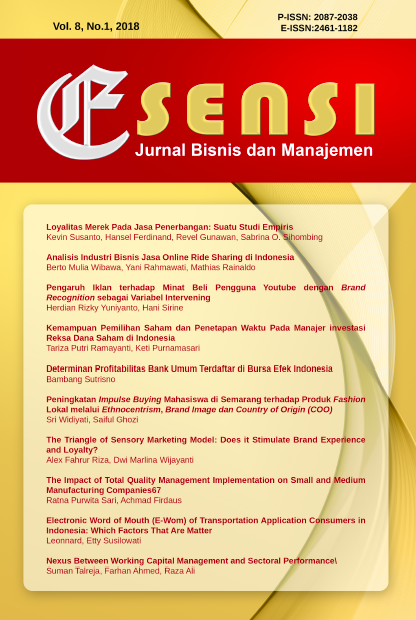Analisis Industri Bisnis Jasa Online Ride Sharing di Indonesia
DOI:
https://doi.org/10.15408/ess.v8i1.5739Keywords:
online ride-sharing service, Porter’s Five Forces, transportationAbstract
Analysis of Online Ride Sharing Business Industry in Indonesia
Innovation in transportation sector with sharing economy principal has create new service sector which is named online ride sharing service. There are a lot of online ride-sharing service players in Indonesia such as Go-Jek, Grab, and Uber. Nowadays, government also have rules on changing the condition of online ride-sharing. Therefore, industry analysis is needed to be analyze further to know the industry attractiveness of the online-ride sharing service. This study aims to analyze the level of attractiveness in online ride-sharing industry in Indonesia. This study used descriptive-explorative method on identifying Porter’s Five Forces as tools in industry analysis. Data collection is using ghost interview method to the selected driver. The conclusion is online-ride sharing industry in Indonesia is quite attractive to be developed in the future because the number of customers has not reached the maximum point, moreover the industry may offer a very diverse product differentiation
DOI: 10.15408/ess.v8i1.5739References
Allio, R., & Fahey, L. (2012). Joan Magretta: What Executives Can Learn From Revisiting Michael Porter. Strategy & Leadership. Vol. 40(2): 5-10.
Datta, A., Malhotra, D. K., & Russel, P. S. (2006). Regional Trade Pacts and the Competitiveness of The US Textile Industry. Competitiveness Review: An International Business Journal. Vol. 16(3/4): 262-276.
Dong, Y., Wang, S., Li, L., & Zhang, Z. (2017). An Empirical Study on Travel Patterns of Internet Based Ride-sharing. Transportation Research Part C: Emerging Technologies. Vol. 86: 1-22.
Dobbs, M. E. (2014). Guidelines for Applying Porter’s Five Forces Framework: a Set of Industry Analysis Templates. Competitiveness Review. Vol. 24(1):32-45.
Flores, O. & Rayle, L. (2017). How Cities Use Regulation for Innovation: The Case of Uber, Lyft and Sidecar in San Francisco. Transportation Research Procedia. Vol. 25: 3756-3768.
Hannigan, T. J., Hamilton III, R. D., & Mudambi, R. (2015). Competition and Competitiveness in The US Airline Industry. Competitiveness Review. Vol. 25(2): 134-155.
Karagiannopoulos, G., Georgopoulos, N., & Nikolopoulos, K. (2005). Fathoming Porter's Five Forces Model In The Internet Era. Info. Vol. 7(6): 66-76.
Laurell, C. & Sandström, C. (2017) The Sharing Economy in Social Media: Analyzing Tensions Between Market and Non-Market Logic. Technological Forecasting and Social Change. Vol. 125: 58-65.
Lee, H., Kim, M., & Park, Y. (2012). An Analytic Network Process Approach to Operationalization of Five Forces Model. Applied Mathematical Modeling. Vol. 36(4): 1783-1795.
Magretta, J. (2012). Understanding Michael Porter: The Essential Guide to Competition and Strategy. Boston: Harvard Business Review Press.
Moon, H. C. & Peery Jr, N. S. (1995). Competitiveness of Product, Firm, Industry, And Nation In A Global Business. Competitiveness Review: An International Business Journal. Vol. 5(1):37-43.
Newton, P., & Bristoll, H. (2013). Porter's Five Forces Strategy Skills. Stratford: Team FME.
Nie, Y. M. (2017). How can the taxi industry survive the tide of ridesourcing? Evidence from Shenzhen, China. Transportation Research Part C. Vol. 79: 242–256.
Porter, M. (1980). Competitive Strategy: Techniques for Analyzing Industries and Competitors. New York: The Free Press.
Porter, M. (1983). Competitive Advantage: Creating and Sustaining Superior Performance. New York: The Free Press.
Porter, M. (2001). Strategy and the Internet. Harvard Business Review. Vol. 89(2): 2-19.
Qiu, X., Cano-Kollmann, M., & Mudambi, R. (2017). Competitiveness and Connectivity in Design Innovation: a Study of Norwegian Furniture Industry. Competitiveness Review: An International Business Journal. Vol. 27(5): 533-548.
Rajasekar, J. & Al Raee, M. (2013). An analysis of The Telecommunication Industry in The Sultanate of Oman using Michael Porter's Competitive Strategy Model. Competitiveness Review: An International Business Journal. Vol. 23(3): 234-259.
Rothaermel, F. T. (2016). Competitive Advantage in Technology Intensive Industries. Advances in the Study of Entrepreneurship, Innovation & Economic Growth. Vol. 26(1): 233-256.
Sutherland, E. (2014). Lobbying and Litigation in Telecommunications Markets- Reapplying Porter's Five Forces. Info. Vol. 16(5): 1-18.
Teece, D. (2010). Business Models, Business Strategy, and Innovation. Long Range Planning. Vol. 43(2): 172-194.
Thursby, M. C., & Berbari, M. (2016). Identifying and Evaluating Market Opportunities. Technological Innovation: Generating Economic Result. Vol. 26(1): 33-58.
Wang, M. & Mu, L. (2017). Spatial disparities of Uber accessibility: An Exploratory Analysis in Atlanta, USA. Computers, Environment and Urban Systems. Vol. 67: 169–175.
Wibawa, B. M. & Baihaqi, I. (2014). Desain Inovasi Model Bisnis Untuk Pengembangan Bisnis Vaksin HydroVac. Konferensi Nasional Riset Manajemen VIII : 1-13.

